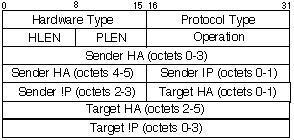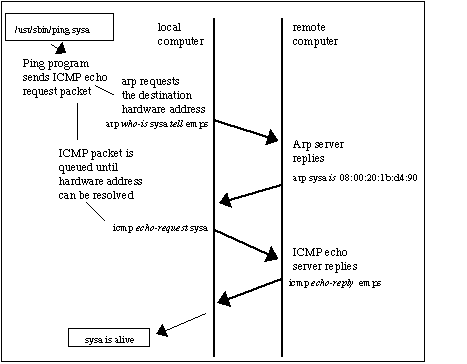
The address resolution protocol is a protocol used by the Internet Protocol (IP) network layer protocol to map IP network addresses to the hardware addresses used by a data link protocol. The protocol operates below the network layer as a part of the OSI link layer, and is used when IP is used over Ethernet.
The term address resolution refers to the process of finding an address of a computer in a network. The address is "resolved" using a protocol in which a piece of information is sent by a client process executing on the local computer to a server process executing on a remote computer. The information received by the server allows the server to uniquely identify the network system for which the address was required and therefore to provide the required address. The address resolution procedure is completed when the client receives a response from the server containing the required address.
An Ethernet network uses two hardware addresses which identify the source and destination of each frame sent by the Ethernet. The destination address (all 1's) may also identify a broadcast packet (to be sent to all connected computers). The hardware address is also known as the Medium Access Control (MAC) address, in reference to the standards which define Ethernet. Each computer network interface card is allocated a globally unique 6 byte address when the factory manufactures the card (stored in a PROM). This is the normal source address used by an interface. A computer sends all packets which it creates with its own hardware source address, and receives all packets which match its hardware address or the broadcast address. When configured to use multicast, a selection of multicast hardware addresses may also be received.
The Ethernet address is a link layer address and is dependent on the interface card which is used. IP operates at the network layer and is not concerned with the network addresses of individual nodes which are to be used. A protocol known as the address resolution protocol (arp) is therefore used to translate between the two types of address. The arp client and server processes operate on all computers using IP over Ethernet. The processes are normally implemented as part of the software driver which drives the network interface card.
There are four types of arp messages which may be sent by the arp protocol. These are identified by four values in the "operation" field of an arp message. The types of message are:
The format of an arp message is shown below:

To reduce the number of address resolution requests, a client normally caches resolved addresses for a (short) period of time. The arp cache is of a finite size, and would become full of incomplete and obsolete entries for computers that are not in use if it was allowed to grow without check. The arp cache is therefore periodically flushed of all entries. This deletes unused entries and frees space in the cache. It also removes any unsuccessful attempts to contact computers which are not currently running.
The figure below shows the use of arp when a computer tries to contact a remote computer on the same LAN (known as "sysa") using the "ping" program. It is assumed that no previous IP datagrams have been received form this computer, and therefore arp must first be used to identify the MAC address of the remote computer.

The arp request message ("who is X.X.X.X tell Y.Y.Y.Y", where X.X.X.X and Y.Y.Y.Y are IP addresses) is sent using the Ethernet broadcast address, and an Ethernet protocol type of value 0x806. Since it is broadcast, it is received by all systems in the same collision domain (LAN). This is ensures that is the target of the query is connected to the network, it will receive a copy of the query. Only this system responds. The other systems discard the packet silently.
The target system forms an arp response ("X.X.X.X is hh:hh:hh:hh:hh:hh", where hh:hh:hh:hh:hh:hh is the Ethernet source address of the computer with the IP address of X.X.X.X). This packet is unicast to the address of the computer sending the query (in this case Y.Y.Y.Y). Since the original request also included the hardware address (Ethernet source address) of the requesting computer, this is already known, and doesn't require another arp message to find this out.

http://www.erg.abdn.ac.uk/users/gorry Date: 10/11/1995 Revised: 7/10/2003